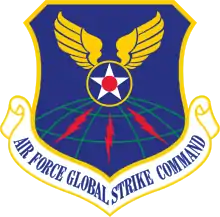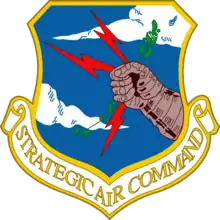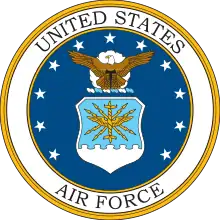319th Missile Squadron
The 319th Missile Squadron is a United States Air Force unit assigned to the 90th Operations Group at Francis E. Warren Air Force Base, Wyoming. The squadron is equipped with the LGM-30G Minuteman III intercontinental ballistic missile, with a mission of nuclear deterrence. It is the flagship squadron of the 90th Missile Wing.
| 319th Missile Squadron | |
|---|---|
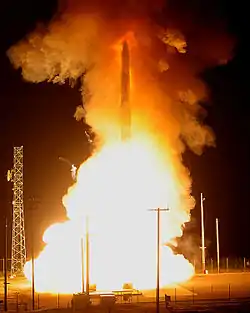 LGM-30G Minuteman III test launch at Vandenberg AFB, California | |
| Active | 1942–1946; 1947–1948; 1951–1960; 1963–present |
| Country | |
| Branch | |
| Type | Squadron |
| Role | Intercontinental ballistic missile |
| Part of | Air Force Global Strike Command |
| Garrison/HQ | Francis E. Warren Air Force Base |
| Nickname(s) | Asterperious (World War II) |
| Engagements | Southwest Pacific Theater |
| Decorations | Distinguished Unit Citation Air Force Outstanding Unit Award Philippine Presidential Unit Citation |
| Commanders | |
| Current commander | Lt Col James Schlabach |
| Insignia | |
| 319th Missile Squadron emblem (Approved 2 September 1955)[1] | 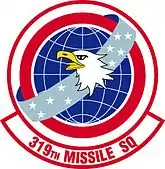 |
| 319th Bombardment Squadron emblem (Approved 11 June 1943)[2][3] | 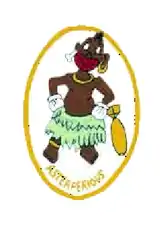 |
| 319th Bombardment Squadron "Jolly Rogers" patch[note 1] | 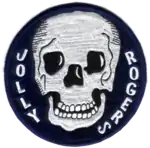 |
The squadron was first activated as the 319th Bombardment Squadron in 1942. It flew Consolidated B-24 Liberators in the Pacific during World War II, where it earned two Distinguished Unit Citations and a Philippine Republic Presidential Unit Citation for its actions in combat. After VJ Day, the squadron remained in the Philippines until January 1946, when it was inactivated.
The squadron was again activated in 1951 at Fairchild Air Force Base, Washington, a Boeing B-29 Superfortress unit. After moving to Forbes Air Force Base, Kansas, it served as a training unit for Strategic Air Command units and aircrews in the B-29. In 1953 it converted to the strategic reconnaissance mission, upgrading to the Boeing RB-47 Stratojet in 1954. After 1958 it trained reconnaissance crews with the B-47 and continued that mission until it was inactivated in 1960.
The squadron was activated again in 1963 as the 319th Strategic Missile Squadron, an LGM-30B Minuteman I squadron. In 1974 it modernized its missiles to the multi-warhead Minuteman III. Following the implementation of the Strategic Arms Reduction Treaty, its missiles were limited to a single warhead.
Mission
The squadron operates 50 LGM-30G Minuteman III intercontinental ballistic missiles on full alert 24 hours a day, 365 days a year.[4] It missiles are dispersed in hardened silos to protect against attack and connected to underground missile alert facilities through a system of hardened cables.[5]
History
World War II
The squadron was first organized as the 319th Bombardment Squadron at Key Field, Mississippi in April 1942 as a Consolidated B-24 Liberator unit and one of the original squadrons of the 90th Bombardment Group. The squadron trained with Liberators in the southeastern United States under III Bomber Command until August.[1][6]
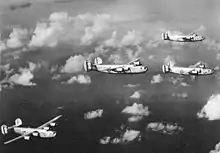
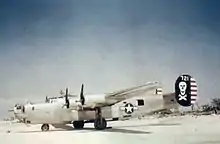
The squadron moved to Willow Run Airport, Michigan for conversion training on newly manufactured Ford Liberators. Assigned to VII Bomber Command with B-24Ds, the unit moved to Hickam Field, Hawaii in September. The squadron arrived in northern Queensland, Australia in November 1942 and began bombardment missions under V Bomber Command almost immediately.[6]
The squadron attacked enemy airfields, troop concentrations, ground installations and shipping in New Guinea, the Bismarck Archipelago, Palau and the southern Philippines. The 319th was awarded a Distinguished Unit Citation for its operations in Papua through January 1943. The unit participated in the Battle of Bismarck Sea in March 1943, and earned another citation for strikes on enemy airfields at Wewak, New Guinea in September 1943 despite heavy flak and fighter opposition.[6]
During 1944, the 319th supported the New Guinea Campaign through the end of June, then made long-range raids on oil refineries at Balikpapan, Borneo, in September and October. In January 1945, the squadron moved to the Philippines and supported ground forces on Luzon, attacked industrial targets on Formosa, and bombed railways, airfields, and harbor facilities on the Asiatic mainland. Shortly before the end of the war in the Pacific, the 90th moved to Okinawa, from which it would be able to strike the Japanese home islands.[6]
After VJ Day, the squadron flew reconnaissance missions over Japan and ferried Allied prisoners of war from Okinawa to Manila. It ceased operations by November 1945. The squadron was inactivated in the Philippines in early 1946.[1]
Superfortress operations
The squadron was reactivated in July 1947 as a very heavy unit at Andrews Field, Maryland. It was a component of one of seven bombardment groups activated at Andrews by Strategic Air Command (SAC) that day. Most of these units, including the 319th, were inactivated by September 1948 and it does not appear they were manned during this period.[1][7][8]

The squadron was again organized at Fairchild Air Force Base, Washington in January 1951 and equipped with the Boeing B-29 Superfortress. In February, as part of a reorganization of Strategic Air Command wings, the 90th Bombardment Group was reduced to paper status and the squadron was attached to the wing for operational control. In June 1952, this organization, which was designed to permit the wing commander to focus on the wing's combat units and the maintenance necessary to support combat aircraft, was formalized as the Dual Deputy Organization and the squadron was assigned to the wing.[9][10]
In March 1951, the squadron moved to Forbes Air Force Base, where it served primarily as a training unit. In May, it began serving as an Operational Training Unit for B-29 aircrews and mechanics of newly-activating units. The squadron help organize and train the 376th, 308th, and 310th Bombardment Wings.[11][12][13]
In June, the squadron added duty as a Replacement Training Unit, primarily providing individual training for aircrew being assigned to existing Far East Air Forces B-29 units during the Korean War.[14][note 3] In November 1952 it also began training replacement crews for the RB-29 reconnaissance model of the Superfortress and SHORAN personnel for Strategic Air Command (SAC). These training activities continued through November 1953.[9]
Strategic reconnaissance
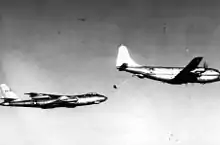
The squadron began to fly strategic reconnaissance missions in September 1953.[9] The following year, it replaced its RB-29s with the jet Boeing RB-47 Stratojet, with the first B-47E arriving on 25 June, although crews had begun training in March.[15] One year later, the squadron and the entire 90th Strategic Reconnaissance Wing deployed as a unit to Eielson Air Force Base, Alaska from 5 May until 31 August 1955, where the wing performed the final mapping of Alaska.[9][16] In May 1958, the 90th Wing returned to the training mission serving as a combat crew training wing for RB-47 aircrews until it was inactivated on 20 June 1960.[9] The squadron's personnel and equipment were transferred to the 25th Bombardment Squadron, which moved to Forbes on paper from Schilling Air Force Base, Kansas the same day.[17]
Intercontinental ballistic missiles
The squadron was reactivated on 1 October 1963 as an intercontinental ballistic missile squadron assigned to the 90th Strategic Missile Wing at Francis E. Warren Air Force Base, Wyoming, and equipped with fifty LGM-30B Minuteman Is, armed with a single reentry vehicle. The squadron was the first of the 90th Wing's four Minuteman squadrons to activate, as construction on launch facilities continued until the middle of 1964. Beginning in June 1973, its Minuteman I missiles began to be replaced by LGM-30G Minuteman IIIs, which could carry up to three reentry vehicles.[9][5] In 2001 in compliance with the Strategic Arms Reduction Treaty, these missiles were limited to a single reentry vehicle[5]
In 1996 the squadron won the Blanchard Trophy as the best missile operations squadron at the Guardian Challenge missile competition and the Samuel C. Phillips Award as the best missile squadron in the command.[18][note 4] In more recent competitions, the squadron won the Neary Trophy and the Linhard Trophy for best USAF missile crew in 2011.[19]
Lineage
- Constituted as the 319 Bombardment Squadron (Heavy) on 28 January 1942
- Activated on 15 April 1942
- Redesignated 319 Bombardment Squadron, Heavy on 6 March 1944
- Inactivated on 27 January 1946
- Redesignated as 319 Bombardment Squadron, Very Heavy on 11 June 1947
- Activated on 1 July 1947
- Inactivated on 6 September 1948
- Redesignated 319 Bombardment Squadron, Medium on 20 December 1950
- Activated on 2 January 1951
- Redesignated 319 Strategic Reconnaissance Squadron, Medium on 16 June 1952
- Discontinued on 20 June 1960
- Redesignated 319 Strategic Missile Squadron (ICBM-Minuteman) on 24 May 1963
- Organized on 1 October 1963
- Redesignated 319 Missile Squadron on 1 September 1991.[1]
Assignments
- 90th Bombardment Group, 15 April 1942 – 27 January 1946
- 90th Bombardment Group, 1 July 1947 – 6 September 1948
- 90th Bombardment Group, 2 January 1951 (attached to 90th Bombardment Wing after 16 February 1951)
- 90th Strategic Reconnaissance Wing, 16 June 1952 – 20 June 1960
- Strategic Air Command, 24 May 1963 (not organized)
- 90th Strategic Missile Wing, 1 October 1963
- 90th Operations Group, 1 September 1991 – present[1]
Stations
|
|
Aircraft and missiles
- Consolidated B-24 Liberator (1942–1945)
- Boeing RB-29 Superfortress (1951–1954)
- Boeing RB-47E Stratojet (1954–1960)
- LGM-30B Minuteman I (1964–1974)
- LGM-30G Minuteman III (1973 – present)[1]
Awards and campaigns
| Award streamer | Award | Dates | Notes |
|---|---|---|---|
| Distinguished Unit Citation | c. 4 November 1942 – 23 January 1943 | Papua, 319th Bombardment Squadron[1] | |
| Distinguished Unit Citation | 13 and 15 September 1943 | New Guinea, 319th Bombardment Squadron[1] | |
| Air Force Outstanding Unit Award | 1 July 1968–30 June 1969 | 319th Strategic Missile Squadron[1] | |
| Air Force Outstanding Unit Award | 1 July 1973–30 June 1975 | 319th Strategic Missile Squadron[1] | |
| Air Force Outstanding Unit Award | 1 July 1982–30 June 1984 | 319th Strategic Missile Squadron[1] | |
| Air Force Outstanding Unit Award | 1 July 1986–30 June 1988 | 319th Strategic Missile Squadron[1] | |
| Air Force Outstanding Unit Award | 1 July 1987–30 June 1989 | 319th Strategic Missile Squadron[1] | |
| Air Force Outstanding Unit Award | 1 August 1991–31 July 1993 | 319th Strategic Missile Squadron (later 319th Missile Squadron)[1] | |
| Air Force Outstanding Unit Award | 1 October 1994–30 September 1995 | 319th Missile Squadron[1] | |
| Air Force Outstanding Unit Award | 1 September 1996–31 August 1998 | 319th Missile Squadron[1] | |
| Air Force Outstanding Unit Award | 1 October 1999–30 September 2000 | 319th Missile Squadron[1] | |
| Air Force Outstanding Unit Award | 1 January 2001–31 December 2001 | 319th Missile Squadron[1] | |
| Air Force Outstanding Unit Award | 1 October 2003–30 September 2005 | 319th Missile Squadron[1] | |
| Air Force Outstanding Unit Award | 1 October 2005–30 September 2007 | 319th Missile Squadron[1] | |
| Air Force Outstanding Unit Award | 1 October 2007–30 September 2008 | 319th Missile Squadron[1] | |
| Philippine Republic Presidential Unit Citation | 17 October 1944–4 July 1945 | 319th Bombardment Squadron[1] |
| Campaign Streamer | Campaign | Dates | Notes |
|---|---|---|---|
| Guadalcanal | c. 4 November 1942 – 21 February 1943 | 319th Bombardment Squadron[1] | |
| Papua | c. 4 November–23 January 1943 | 319th Bombardment Squadron[1] | |
| Northern Solomons | 23 February 1943 – 21 November 1944 | 319th Bombardment Squadron[1] | |
| Bismarck Archipelago | 15 December 1943 – 27 November 1944 | 319th Bombardment Squadron[1] | |
| New Guinea | 24 January 1943 – 31 December 1944 | 319th Bombardment Squadron[1] | |
| Leyte | 17 October 1944 – 1 July 1945 | 319th Bombardment Squadron[1] | |
| Luzon | 15 December 1944 – 4 July 1945 | 319th Bombardment Squadron[1] | |
| Southern Philippines | 27 February 1945 – 4 July 1945 | 319th Bombardment Squadron[1] | |
| China Defensive | November 1942–4 May 1945 | 319th Bombardment Squadron[1] | |
| China Offensive | 5 May 1945 – 2 September 1945 | 319th Bombardment Squadron[1] | |
| Air Offensive, Japan | November 1942–2 September 1945 | 319th Bombardment Squadron[1] | |
| Western Pacific | 17 April 1944 – 2 September 1945 | 319th Bombardment Squadron[1] |
See also
References
Notes
- The 90th Bombardment Group "Jolly Rogers" emblem was used as a squadron patch and as a tail marking on B-24s with each squadron having its own color in the background. Watkins, pp. 86–87
- Aircraft is Boeing B-29-100-BW Superfortress serial 45-21846
- Replacement Training Units trained individuals to fill positions in existing units. See Goss, p. xxxvi
- The Blanchard Trophy was awarded at the squadron level for only a few years. For most of its existence it was awarded at the wing level. The 90th Wing has also won this award. 90th Missile Wing Heritage Pamphlet, p. 26
Citations
- Robertson, Patsy (6 December 2012). "Factsheet 319 Missile Squadron (AFGSC)". Air Force Historical Research Agency. Archived from the original on 3 March 2016. Retrieved 15 May 2016.
- Endicott (unpaginated)
- Watkins, pp. 86–87
- "F.E. Warren Air Force Base: Units". 90th Missile Wing Public Affairs. Retrieved 8 May 2016.
- "90 MW Fact Sheet". 90th Missile Wing Public Affairs. 19 August 2010. Retrieved 8 May 2016.
- Robertson, Patsy (27 May 2010). "Factsheet 90 Operations Group (AFSPC)". Air Force Historical Research Agency. Retrieved 11 May 2016.
- Mueller, p. 8
- Maurer, Combat Units, pp. 102, 176, 178
- Robertson, Patsy (6 April 2012). "Factsheet 90 Missile Wing (AFGSC)". Air Force Historical Research Agency. Retrieved 8 May 2016.
- Deaile, pp. 175–176
- Ravenstein, pp. 200–202
- Robertson, Patsy (27 August 2015). "Factsheet 308 Armament Systems Wing (AFMC)". Air Force Historical Research Agency. Archived from the original on 27 September 2015. Retrieved 8 August 2017.
- Kane, Robert B. (23 December 2010). "Factsheet 310 Space Wing (AFRC)". Air Force Historical Research Agency. Retrieved 9 May 2016.
- "Abstract, History 90 Bombardment Wing". Air Force History Index. 1 October 1951. Retrieved 9 May 2016.
- 90th Missile Wing Heritage Pamphlet, pp. 3, 15
- 90th Missile Wing Heritage Pamphlet, p. 15
- Ravenstein, p. 68
- 90th Missile Wing Heritage Pamphlet, p. 20
- 90th Missile Wing Heritage Pamphlet, p. 26
Bibliography
![]() This article incorporates public domain material from the Air Force Historical Research Agency website http://www.afhra.af.mil/.
This article incorporates public domain material from the Air Force Historical Research Agency website http://www.afhra.af.mil/.
- Deaile, Melvin G. (2007). The SAC Mentality: The Origins of Organizational Culture in Strategic Air Command 1946–1962. Chapel Hill, NC: University of North Carolina. Retrieved 14 February 2015.
- Endicott, Judy G. (1998). Active Air Force Wings as of 1 October 1995 and USAF Active Flying, Space, and Missile Squadrons as of 1 October 1995 (PDF). Air Force History and Museums Program. Washington, DC: Office of Air Force History. ASIN B000113MB2. Retrieved 2 July 2014.
- Goss, William A (1955). "The Organization and its Responsibilities, Chapter 2 The AAF". In Craven, Wesley F; Cate, James L (eds.). The Army Air Forces in World War II. Vol. VI, Men & Planes. Chicago, Illinois: University of Chicago Press. LCCN 48003657. OCLC 704158.
- Maurer, Maurer, ed. (1983) [1961]. Air Force Combat Units of World War II (PDF) (reprint ed.). Washington, DC: Office of Air Force History. ISBN 0-912799-02-1. LCCN 61060979.
- Maurer, Maurer, ed. (1982) [1969]. Combat Squadrons of the Air Force, World War II (PDF) (reprint ed.). Washington, DC: Office of Air Force History. ISBN 0-405-12194-6. LCCN 70605402. OCLC 72556.
- Mueller, Robert (1989). Air Force Bases, Vol. I, Active Air Force Bases Within the United States of America on 17 September 1982 (PDF). Washington, DC: Office of Air Force History. ISBN 0-912799-53-6.
- Ravenstein, Charles A. (1984). Air Force Combat Wings, Lineage & Honors Histories 1947–1977. Washington, DC: Office of Air Force History. ISBN 0-912799-12-9.
- Watkins, Robert A. (2013). Insignia and Aircraft Markings of the U.S. Army Air Force in World War II. Volume V, Pacific Theater of Operations. Atglen,PA: Shiffer Publishing, Ltd. ISBN 978-0-7643-4346-9.
- "90th Missile Wing Heritage" (PDF). Office of History 90th Missile Wing. Retrieved 9 May 2016.
External links
- Kirk, Jim. "Warren AFB Minuteman Missile Site Coordinates". ASUW Link. Archived from the original on 25 June 2014. Retrieved 31 May 2016.
- Fields, Dave. "Minuteman Missile: A Tribute to the ICBM Program". Dave Fields. Archived from the original on 7 July 2016. Retrieved 7 July 2016.
